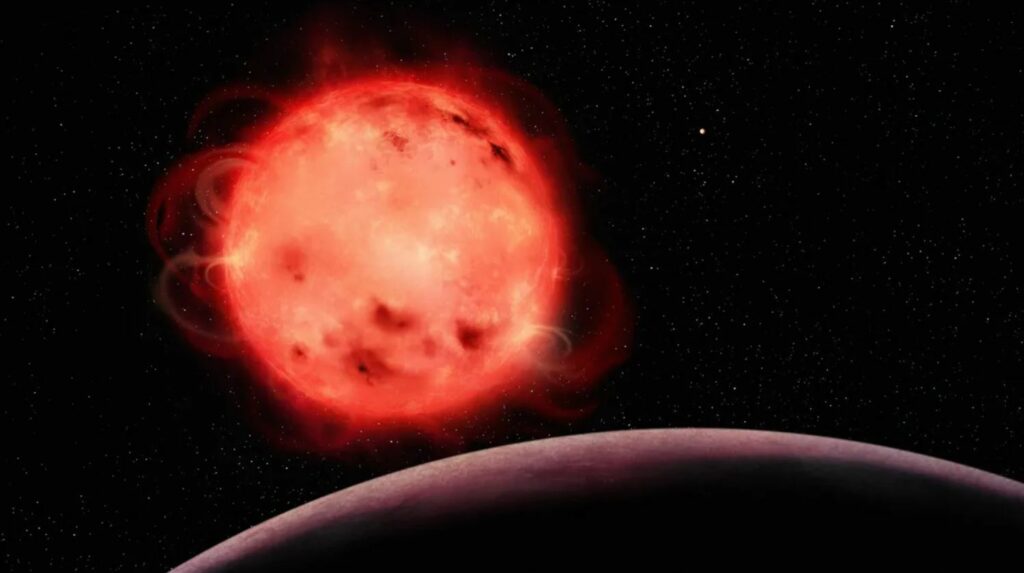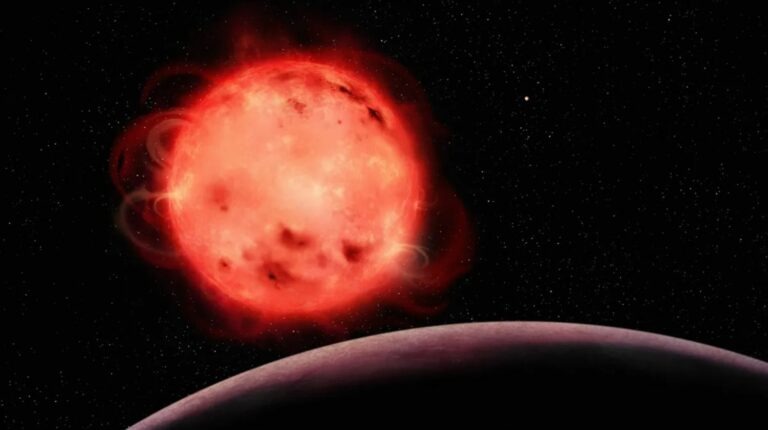The James Webb Space Telescope has unveiled that the TRAPPIST-1 exoplanet appears to lack an atmosphere, but the answer to this mystery might be connected to its host star.
Churning magnetic activity on the surface of TRAPPIST-1’s red dwarf star is interfering with the JWST’s efforts to determine whether any of the orbiting planets are habitable.
Efforts to observe the atmospheres of planets in the TRAPPIST-1 system are being stymied by rambunctious activity on the surface of the red dwarf star at its center, new findings from the James Webb Space Telescope (JWST) show.
In March 2023, the JWST‘s Mid-Infrared Instrument (MIRI) observed a secondary transit of one of the TRAPPIST-1 planets, known as TRAPPIST-1b. The observatory found that the planet, which is the innermost world of this system and a little more massive than Earth, is probably bare rock with no atmosphere to speak of and a surface temperature of 232 degrees Celsius (450 degrees Fahrenheit). Similar results came for the next planet in this system, TRAPPIST-1c, three months later. These two worlds seem analogous to Mercury, which is the innermost planet of our solar system.

And new observations, from a team of astronomers led by Olivia Lim of the University of Montréal, corroborate these earlier findings by taking the first ever spectrum of a planet in the TRAPPIST-1 system, specifically TRAPPIST-1b.
While a thin atmosphere cannot yet be ruled out on TRAPPIST-1b, the spectrum captured by JWST’s Near Infrared Imager and Slitless Spectrograph (NIRISS) shows no evidence for a thick, hydrogen-dominated atmosphere. However, there is one interesting caveat to these findings.
“What we do see is that the star is absolutely the biggest effect dominating our observations, and this will do the exact same thing to other planets in the system,” said team-member Ryan MacDonald of the University of Michigan in a statement.
Or in other words, that tumultuous red dwarf might be preventing scientists from learning the truth about whether TRAPPIST-1 can be considered habitable or not.
To take a spectrum of an exoplanet‘s atmosphere requires use of a method known as transmission spectroscopy. When a planet transits between its star and our vantage point on Earth, much of the starlight is blocked by the planet itself, but some of that light also shines through the planet’s atmosphere (if it has one). Those rays that go through the atmosphere also get absorbed by molecules in the atmosphere at characteristic wavelengths. And if that light hits our Earth-based detectors, scientists can then look for the absorption lines in a planet’s spectrum to discern what gases are present in the world’s atmosphere.
But the problem is that red dwarf stars like TRAPPIST-1 are typically very active stars, with bright faculae and large, dark star-spots. These features interfere with measurements of a planet’s spectrum, creating contrasting bright lines and dark lines that can mimic absorption lines.
“In addition to the contamination from stellar spots and faculae, we saw a stellar flare, an unpredictable event during which the star looks brighter for several minutes to hours,” said Lim. “This flare affected our measurement of the amount of light blocked by the planet.”
There are ways to mitigate this, though.
One solution is to try and model what the stellar activity on the surface of TRAPPIST-1 is like, and then remove it from the data before analysis — the other is to model the stellar contamination and the planet’s atmosphere together and fit them to various models of what the planet’s spectrum might look like depending on different kinds of atmospheres.
Lim’s team took both approaches, and came up with the same result both times: TRAPPIST-1b lacks a thick hydrogen atmosphere, and its spectrum can be fully described by the star’s activity.
This is not surprising; of all seven planets in the TRAPPIST-1 system, planet b is the most likely not to have an atmosphere because it feels the full brunt of the star’s stellar wind and violent flares that can blow an atmosphere away. However, it’s impossible to say whether the planet has a thinner atmosphere of water vapor, carbon dioxide or methane, as the uncertainties incurred by the star’s activity are an order of magnitude greater than the precision required to detect such an atmosphere.
This will pose serious problems for observing the spectrum of the other worlds in the system.
“If we don’t figure out how to deal with the star now, it’s going to make it much, much harder when we look at the planets in the habitable zone – TRAPPIST-1d, e and f – to see any atmospheric signals,” said McDonald.
The findings were published on Sept. 22 in The Astrophysical Journal Letters.
Source: SpaceCom
Do not forget to share your opinion with us to provide you with the best posts !




0 Comments